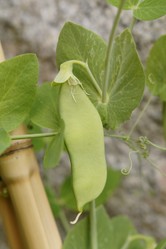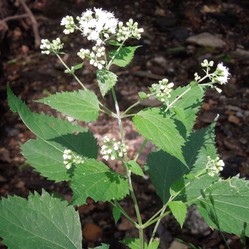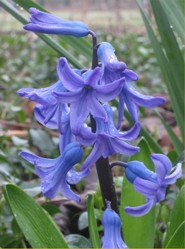The commonest that gardeners will meet is thigmotropism, also known as haptotropism, which involves sensitivity to touch. You have all seen beans and peas attaching themselves to a pole. This is an example of thigmotropism that gardeners use to support their plants. What happens is that tendrils respond to contact by curling round the supporting plant. It is also the case that Convolvulus [bindweed, which is a common weed on allotments] attaches itself to plants in the same way. Roots display negative thigmotropism when they move away on contact with a stone.
Chemical tropism is common and has several different types. The basic process involved in all is response of the plant to ions moving in the soil.
One form of tropism commonly known to gardeners is hydrotropism, which is a movement in roots towards a water source. Movement towards dampness is known as hygrotropism and is just a form of hydrotropism. The classic example of hydrotropism is the carrot. Carrot seedlings throw down a long taproot towards a deep water source, which is a legacy of carrots' origin as a desert plant. Growers often use this tendency to enable them to grow long carrots by growing in tubes which are watered from the bottom.The long roots that search for water thicken out to produce long carrots. This form of tropism is also found in tomato roots, parsnips and radishes. . The mechanism of hydrotropism is thought to be connected with the presence of abscisic acid in plant roots.
In arid conditions hydrotropism counteracts geotropism because arid conditions diminish the supply of amyloplasts and statocytes, thus weakening geotropic forces without lesening hydrotropic ones. It is also known that plants
Chemotropism is a response to chemicals in the soil. Many plant roots grow towards useful minerals and away from harmful acids.Roots in some plants cam display positive chemotropism in one temperature range and ngeativ chemotropism in another. A minor form of chemical tropism is aerotropism, in which plant roots grow towards an oxygen source,
A vital instance of chemotropism occurs in pollination, as the pollen's landing on the stigma, the plant's female organ, elicits a response from the ovule, which causes a pollen tube to develop down which the male pollen travels to fertilise the ovule
A final kind of tropism is thermotropism, which is movement of a plant towards a heat source. This can be found in house plants which are drawn towards radiators, bananas being an example. But outdoors this tropism also operates. It is well-known that maize likes a warm stem, but cool roots, and it has been noted that if there is any temperature incline in the soil in which maize is grown its roots will grow towards the cooler side,though this does not operate in cold conditions unsuitable for maize.
Knowledge of common tropisms is useful to gardeners. We do not need to be thinking about it all the time, but it is a weapon in the gardener's armoury of knowledge.










 Pilgrimage. A reviewon 06/15/2025
Pilgrimage. A reviewon 06/15/2025
 Leo the Fourteenthon 05/09/2025
Leo the Fourteenthon 05/09/2025
 The Melsonby Hoardon 03/25/2025
The Melsonby Hoardon 03/25/2025




Comments
The main change wrought by pruning is that if the main stem of a tree is severed it turns bushy as its auxins, which stiflebgrowth of lower branches and are made by the main stem are lost.
Thank you for your comment below in answer to my previous observation and question.
The fifth paragraph to the second subheading, Sky and earth, advises us that "But tropism can be negative to light, for there is also geotropism, sometime known as gravitotropism, which is characteristic of roots. Roots grow downwards because at the root tip they have an elongation zone. Within the roots we find organelles called amyloplasts, which contain starch, which weighs them downwards towards the earth. Within these organelles are gravity sensitive cells called statocytes, which ensure downward growth."
Are different plants attune to different biogeographical and temporal definitions of their gravitotropism?
For example, do some find their gravitotropism less or more injured by extensive or minimal or moderate root-pruning than others?
We have not given up on displays, but as numbers at meetings are small and members are ageing the possibility does not look promising.
Thank you for your comment below in answer to my previous observation and question.
The COVID shutdown had such a wide socio-politico-economic impact!
Is it possible that the society losing members means not only no tropism display but also no displays ever at all?
No, the Ovid epidemic caused the cancellation of the show, and in that period the society lost members.
Thank you for your comment below in answer Sep. 17, 2020, to my previous, same-day observation and question.
The educational displays acts as such community-education tools. Did the tropism-related display get realized?
I concur. Plants respond to electrical fields, but nowhere have I heard mentioned the phenomenon of which you speak. I suspect that this might be a tropism of certain plants in dry regions.As it would be the roots that absorbed water, it may be that the esters are a side effect of the plants' readiness. But here I , who is not a great chemist, am getting beyond my level of competence.
Frank, this might be another form of tropism, or something close but distinct. Many years ago an engineer told me the odor before a thunderstorm is not ozone, which I concur with since I know the smell of ozone. He suggested that electric field changes signal plants to open for the reception of water, and the odor is probably esters that are released in the process. I suppose opening for the reception of water is tropism, but the chemical process that releases esters, if that is what is released, I am tempted to say meets the definition. Do you concur?
Yes, there will be an article on the display, but much later in the year.
frankbeswick, Thank you for the practical information and the product lines.
All this tropism information appeals to me in terms of understanding and witnessing above- and below-ground plant growth (wouldn't it be nice if tree branches would, like roots distinguishing between harmful acids and useful minerals, grow away from, instead of into and over, our power lines?).
In particular, I'm thinking of the way all plant parts in epiphytes, and buttress roots in bald cypresses, are exposed. How many tropisms do epiphytes harbor, and do their air-borne roots (and the mounded parts of bald cypress roots) react counter, not at all or toward light?
Will there be a follow-up article on the actual, completed display?